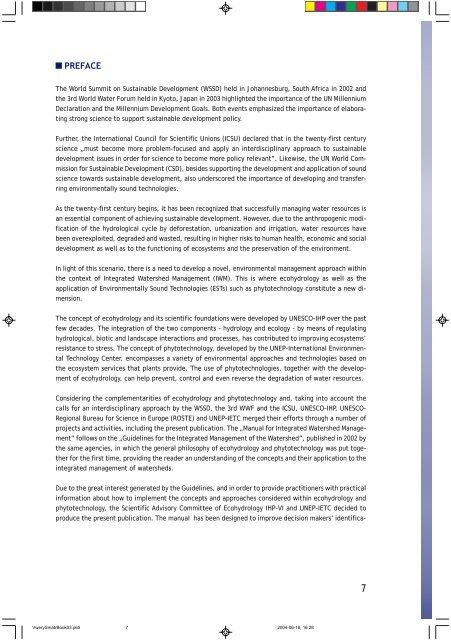Manual - International Environmental Technology Centre
Manual - International Environmental Technology Centre
Manual - International Environmental Technology Centre
You also want an ePaper? Increase the reach of your titles
YUMPU automatically turns print PDFs into web optimized ePapers that Google loves.
PREFACE<br />
The World Summit on Sustainable Development (WSSD) held in Johannesburg, South Africa in 2002 and<br />
the 3rd World Water Forum held in Kyoto, Japan in 2003 highlighted the importance of the UN Millennium<br />
Declaration and the Millennium Development Goals. Both events emphasized the importance of elaborating<br />
strong science to support sustainable development policy.<br />
Further, the <strong>International</strong> Council for Scientific Unions (ICSU) declared that in the twenty-first century<br />
science „must become more problem-focused and apply an interdisciplinary approach to sustainable<br />
development issues in order for science to become more policy relevant”. Likewise, the UN World Commission<br />
for Sustainable Development (CSD), besides supporting the development and application of sound<br />
science towards sustainable development, also underscored the importance of developing and transferring<br />
environmentally sound technologies.<br />
As the twenty-first century begins, it has been recognized that successfully managing water resources is<br />
an essential component of achieving sustainable development. However, due to the anthropogenic modification<br />
of the hydrological cycle by deforestation, urbanization and irrigation, water resources have<br />
been overexploited, degraded and wasted, resulting in higher risks to human health, economic and social<br />
development as well as to the functioning of ecosystems and the preservation of the environment.<br />
In light of this scenario, there is a need to develop a novel, environmental management approach within<br />
the context of Integrated Watershed Management (IWM). This is where ecohydrology as well as the<br />
application of <strong>Environmental</strong>ly Sound Technologies (ESTs) such as phytotechnology constitute a new dimension.<br />
The concept of ecohydrology and its scientific foundations were developed by UNESCO-IHP over the past<br />
few decades. The integration of the two components - hydrology and ecology - by means of regulating<br />
hydrological, biotic and landscape interactions and processes, has contributed to improving ecosystems’<br />
resistance to stress. The concept of phytotechnology, developed by the UNEP-<strong>International</strong> <strong>Environmental</strong><br />
<strong>Technology</strong> Center, encompasses a variety of environmental approaches and technologies based on<br />
the ecosystem services that plants provide. The use of phytotechnologies, together with the development<br />
of ecohydrology, can help prevent, control and even reverse the degradation of water resources.<br />
Considering the complementarities of ecohydrology and phytotechnology and, taking into account the<br />
calls for an interdisciplinary approach by the WSSD, the 3rd WWF and the ICSU, UNESCO-IHP, UNESCO-<br />
Regional Bureau for Science in Europe (ROSTE) and UNEP-IETC merged their efforts through a number of<br />
projects and activities, including the present publication. The „<strong>Manual</strong> for Integrated Watershed Management”<br />
follows on the „Guidelines for the Integrated Management of the Watershed”, published in 2002 by<br />
the same agencies, in which the general philosophy of ecohydrology and phytotechnology was put together<br />
for the first time, providing the reader an understanding of the concepts and their application to the<br />
integrated management of watersheds.<br />
Due to the great interest generated by the Guidelines, and in order to provide practitioners with practical<br />
information about how to implement the concepts and approaches considered within ecohydrology and<br />
phytotechnology, the Scientific Advisory Committee of Ecohydrology IHP-VI and UNEP-IETC decided to<br />
produce the present publication. The manual has been designed to improve decision makers’ identifica-<br />
VwerySmatrBook03.p65 7<br />
2004-06-18, 16:28<br />
7

















